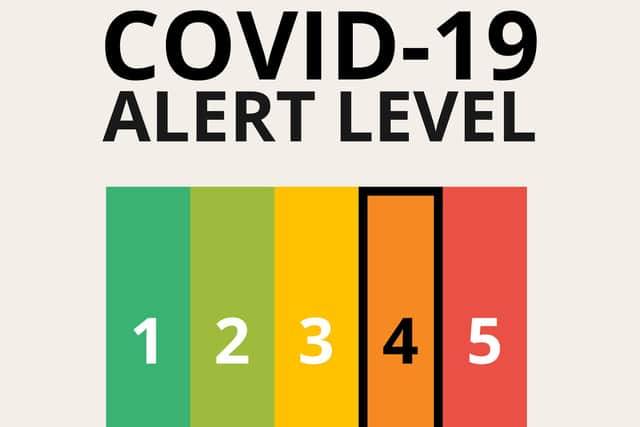Covid alert level: why has the UK’s coronavirus alert level changed to 4 - and what do the levels mean?
The UK's Covid alert level has changed following advice from the four chief medical officers of the devolved nations.
The alert level was raised to five - the highest tier - when Prime Minister Boris Johnson announced England was to move into a third national lockdown in response to the pandemic.
Advertisement
Hide AdAdvertisement
Hide AdCoronavirus variants in circulation at the time were given as reasons for a surge in infections and hospital admissions, which prompted the lockdown and shift in the Covid alert level.


Yet, as the coronavirus vaccine rollout continues to offer the most at risk groups protection from the deadly disease and lockdown measures limit its spread, the situation is improving.
Why has the alert level changed?
The UK's alert level has been lowered from five to four in response to the overall threat of the NHS being overwhelmed within 21 days receding, according to the country's top medics.


England’s Professor Chris Whitty, Scotland’s Dr Gregor Smith, Northern Ireland’s Dr Michael McBride, Wales’s Dr Frank Atherton and NHS England’s Professor Stephen Powis were involved in the decision after Joint Biosecurity Centre advice.
Advertisement
Hide AdAdvertisement
Hide AdA joint statement said that numbers were "consistently declining" thanks to the efforts of the public but warned that health services across the four nations remain under "significant pressure with a high number of patients in hospital".
It read: "We should be under no illusions – transmission rates, hospital pressures and deaths are still very high. In time, the vaccines will have a major impact and we encourage everyone to get vaccinated when they receive the offer.
"However for the time being it is really important that we all – vaccinated or not – remain vigilant and continue to follow the guidelines.
"We know how difficult the situation has been and remains to be for healthcare workers, we thank them for their immense effort, skill and professionalism throughout the pandemic."
What do the Covid alert levels mean?
Advertisement
Hide AdAdvertisement
Hide AdSince the early days of the pandemic, a five-tiered Covid alert system has been used by the government's medical advisors to demonstrate their understanding of the disease and the severity of the virus outbreak across the country.
Decisions are made based on numbers and expert judgement to build public trust and avoid "unnecessary, unpredictable or frequent" changes to the alert levels listed below:
| Level 1 - Covid is not known to be present in the UK Level 2 - Covid is present in UK, but the number of cases and transmission is low Level 3 - a Covid epidemic is in general circulation Level 4 - a Covid epidemic is in general circulation; transmission is high or rising exponentially Level 5 - there is a substantial risk of healthcare services being overwhelmed |
When could the Covid alert level change again?
The alert level could change very quickly if the experts see reason for doing so, based on the number of Covid cases and the speed of its spread, as well as medical judgements.
Advertisement
Hide AdAdvertisement
Hide AdIf the level escalates, like it did on 4 January when lockdown measures were introduced, it can signal to the public that the virus is spreading quickly and to take extra care.
The alert level will drop as the risk posed by Covid reduces, though medics will want to see a sustained downward trend in numbers before establishing a change down the scale.
A change in the alert level doesn't necessarily lead to a change in the Covid restrictions in place - it is separate to government decisions over policy measures put in place by No.10.
Mr Johnson has outlined a roadmap out of the third national lockdown, with a gradual easing of restrictions coming at four intervals from 8 March, 12 April, 17 May, and 21 June.